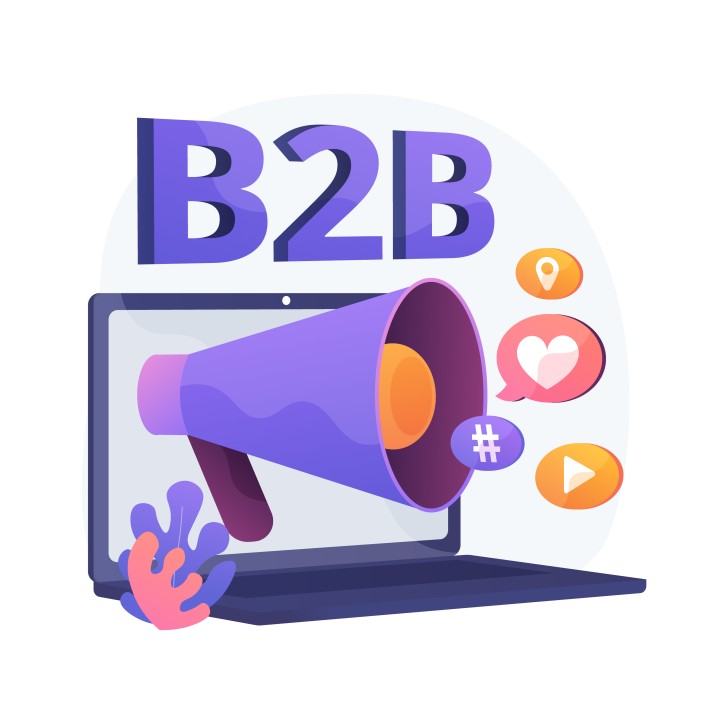Hello!
Between multiple creative campaigns, budget limits, and strategic decision-making, marketers have a lot to juggle when crafting an effective B2B marketing strategy.
The most crucial determinant, however, is the target audience. If you don’t have a focused approach toward SaaS buyers, everything will fall flat.
 On the other hand, appropriate targeting can help your B2B SaaS company build brand awareness, attract potential customers, generate leads, and convert them into paying loyal customers.
On the other hand, appropriate targeting can help your B2B SaaS company build brand awareness, attract potential customers, generate leads, and convert them into paying loyal customers.
However, B2B SaaS marketing needs a different approach than B2C marketing. The reason is that your target audience and sales cycles vary from B2C companies. The B2B audience demands long-term solutions offering expertise, efficiency, and high ROI.
So, you need to deploy robust marketing tactics for lead generation and SaaS customer retention, contributing to revenue generation in the long term.
In this post, we will discuss six powerful B2B marketing tips to help you achieve the goal without hassles.
Let’s get started!
Top B2B Marketing Tactics to Boost Revenue Generation
#1: Understand and Analyze Your Target Market Thoroughly
A recent survey revealed that 65% of customers expect brands to value and understand their ever-evolving needs. Understanding the target market is thus pivotal to delivering tailored buying experiences.
 So, begin with an in-depth target market analysis. Figure out accurate data on customer pain points, preferences, patterns, SaaS industry trends, and more. Leveraging this information can help you create and optimize personalized marketing strategies.
So, begin with an in-depth target market analysis. Figure out accurate data on customer pain points, preferences, patterns, SaaS industry trends, and more. Leveraging this information can help you create and optimize personalized marketing strategies.
The result? Enhanced user engagement and loyalty, driving revenue generation for your SaaS business.
Pro Tip: Use advanced marketing reporting tools to generate detailed reports that provide in-depth insights into the target market.
#2: Drive Organic Traffic with Effective SEO-Driven Content
High-quality, SEO-driven content is a crucial pillar of successful B2B marketing.
It can help increase your online visibility, boost rankings in search engines, and drive relevant organic traffic and leads.
The higher the amount of leads, the higher the chances of converting one.
Besides, this content can help establish your SaaS business as a thought leader, creating credibility and building a positive brand image. This can help drive revenue generation in the long term.
 Here are a few vital tips for creating effective SEO-driven content.
Here are a few vital tips for creating effective SEO-driven content.
- Create content on topics describing SaaS industry trends, how your products and services can resolve the target audience’s pain points, and more. In short, write that resonates with your audience the most.
Leverage tools like Google Analytics and Keyword Planner to research keywords and craft compelling topic ideas. Besides, use tools like Google Trends to explore specific topics trending in the B2B SaaS industry.
- Ensure the content is valuable, well-researched, and adheres to Google’s E-E-A-T parameters (Experience, Expertise, Authoritativeness, and Trustworthiness).
- Optimize meta descriptions (155-160 characters) and meta titles (50-60 characters) for each piece of content. They help search engines like Google to get the context of the page. Also, they appear when users run a relevant search. Optimizing them can thus increase your business’s visibility in SERPs.
- Create content in different formats like blog posts, research reports, infographics, informative podcasts, webinars, and more to keep the audience engagement quotient high. This tactic can also help showcase your expertise as a SaaS brand.
- Adopt a solid internal linking strategy and link relevant blog posts or landing pages on your website to each other. This practice allows the target audience to understand more about your product and service offerings. Besides, this practice can increase the dwell time (time your users stay on the page), a crucial Google ranking signal.
For instance, here is some content from B2B SaaS company Scrut Automation, following the tactics above.
From using relevant content topics and formats aligning with Google’s E-E-A-T parameters to incorporating crucial SEO tactics like keywords, meta tags, and internal linking, this type of content is the sort your business should be publishing.
So, follow the footsteps of this B2B SaaS company to create a winning SEO-driven content strategy.
#3: Strengthen Your Social Media Presence
 It’s a myth that social media works well only for B2C brands.
It’s a myth that social media works well only for B2C brands.
The reality? It isn’t just B2C buyers. B2B decision-makers and C-suite executives also leverage social platforms to explore SaaS products and services.
However, social media marketing for B2B brands can be challenging because they have a lengthy sales cycle. So, the conversion rate through social channels can be slow.
However, B2B marketers can utilize social platforms to build brand awareness, which can help attract the right prospects and enhance revenue generation in the long term.
Here’s how you can get started:
Choose the right social platforms. For instance, leverage the most popular B2B social platforms like Facebook, YouTube, LinkedIn, Instagram, Twitter, Quora, and more to build strong engagement.
Next, focus on your social content strategy. Unlike B2C, your B2B social content must be specific around brand value and not just for entertainment. You should plan to track key social metrics like shares, likes, comments, clicks, and more. This will help you gauge the engagement rate.
 Here are some more crucial tactics to consider:
Here are some more crucial tactics to consider:
- Share posts that reflect your brand expertise. For instance, share quick product demo videos, tutorials, new product feature updates, and so on. Remember that the followers can be your potential leads that might convert to customers.
- Don’t be self-promotional. Instead, list out end benefits for the users and maybe share genuine testimonials of your clients as social proof.
- Include relevant hashtags and geotags to increase your reach among the target audience without hassles.
- Interact frequently with your followers or potential customers to address their challenges or provide information on your B2B SaaS products, services, and pricing.
- In addition to organic content, use paid social marketing. Leverage paid ad campaigns, including Google AdWords, LinkedIn campaigns, Facebook campaigns, and display Ads to reach the relevant audience on popular social media platforms.
 Pro Tip: Uplift your paid social marketing game by partnering with B2B SaaS marketing experts.
Pro Tip: Uplift your paid social marketing game by partnering with B2B SaaS marketing experts.
A reputable social media advertising agency can deliver impactful paid social marketing strategies that yield positive outcomes.
#4: Offer Multiple Pricing Plans
B2B customers often have varying requirements and budgets, which evolve with time.
So, they might not immediately require the products, services, or specific features in solutions they’re already using. For instance, a SaaS startup using basic features or services might want to upgrade to premium services eventually, but only as their business expands.
This calls for innovation in your product development and pricing plan strategy.
According to McKinsey, 30% of pricing plans made by companies don’t yield the best value to customers, resulting in poor revenue. On the other hand, the right pricing model can help attract relevant leads and boost conversions and retention.
So, ensure your team offers multiple pricing plans catering to the diverse needs of your B2B SaaS clients.
 Here are a few pricing plans to offer to your SaaS clients:
Here are a few pricing plans to offer to your SaaS clients:
- Tiered Pricing Plan: This pricing plan enables customers to choose from various tiers, such as basic, premium, or enterprise. These tiers provide several levels of services and product features.
- Pay-Per-Use Plan: This SaaS pricing plan allows customers to pay according to their SaaS product or service consumption.
- Subscription Plan: This plan allows customers to pay recurring charges for SaaS products or services (on a monthly, yearly, or annual basis).
- Tailored Plan: This B2B SaaS pricing plan allows customers to choose specific SaaS services or products according to their unique business requirements.
Once your SaaS pricing plan is ready, create a landing page highlighting the offerings with the utmost clarity. Include an easy-to-digest breakdown of benefits, services, or product features for each pricing plan.
What’s more? Add your pricing plan landing page’s link to blog posts, social posts, and emails to boost marketing efforts and engage relevant leads.
Notice how Slack, a leading team communication and collaboration software provider, leverages these tactics to showcase its tiered pricing plan.
#5: Incorporate a Robust Loyalty Program
 A recent report affirms that 78% of customers stay loyal to businesses rewarding them.
A recent report affirms that 78% of customers stay loyal to businesses rewarding them.
Another report states that customers in the top-performing loyalty programs are more likely to choose a business over its competitors, purchase more often, and pay high prices to stay with them.
This reflects that a well-crafted customer loyalty program can prove a powerful differentiator for your SaaS. It can make your brand stand out from competitors and win more customers.
After all, loyal customers are brand advocates who often refer and help businesses acquire new clients through positive word-of-mouth.
No wonder, all leading SaaS businesses, such as IBM, MailChimp, and Telarus, have incorporated robust loyalty programs in their B2B marketing strategy.
 Here are some tips for a robust loyalty program and transforming your existing customers into loyal communities:
Here are some tips for a robust loyalty program and transforming your existing customers into loyal communities:
- Segment your high-paying and old customers from the rest and provide exclusive discounts and offers. For instance, you can offer a costly product or service at a lower price than the market selling price. This can increase your sales while improving customer retention, a critical factor for earning revenue in the long term.
- Offer monetary incentives to customers who have helped you earn referrals. This tactic can encourage them further to stay associated with your brand while strengthening and nurturing the relationship.
- Grant early access to SaaS product updates to your loyal community of customers. This can make your community feel valued and motivate them to try your new offerings.
- Share exclusive access to crucial company events with your loyal audience. This idea can boost engagement while allowing your customers to witness your brand’s journey.
- Collect feedback from your loyal customers about the loyalty program’s offerings. Understand and analyze whether they are satisfied with the program. Use their input to make the loyalty program more relevant for them.
#6: Track the Right KPIs and Refine Your Strategies Continuously
It’s a no-brainer: Tracking key performance indicators or KPIs is pivotal to analyzing the effectiveness of B2B marketing campaigns.
However, the key here is to track the most relevant growth metrics rather than surface-level or vanity metrics. This can foster informed decisions, driving revenue growth.
 Here’s what you should consider monitoring:
Here’s what you should consider monitoring:
- Marketing Qualified Leads (MQLs): This metric refers to potential business customers who show interest in SaaS products or services, either by subscribing to newsletters, signing up for the upcoming webinar, or acting on any other B2B marketing effort. MQLs often fit the ideal customer profile and thus can be worked into the pipeline.
- Sales Qualified Opportunities (SQOs): Qualified by the sales team, SQOs are opportunities that are highly likely to become customers. So, this is a crucial B2B marketing success metric and can establish a foundation for revenue. Besides, it can help gauge and improve the effectiveness of marketing campaigns.
- Cost Per Lead (CPL): This metric evaluates the total amount a marketer requires to acquire a potential customer. This helps calculate the cost-effectiveness of a marketing campaign. B2B SaaS marketers can use this metric to optimize budget allocation for lead generation.
- Lead to Conversion Ratio: This evaluates the number of qualified B2B leads that become customers. Tracking this can help identify opportunities to improve conversions.
- Return on Ad Spend (ROAS): This metric refers to the total revenue earned for every dollar spent on a marketing ad campaign. Tracking ROAS can help evaluate the effectiveness of marketing ad campaigns.
- Monthly Recurring Revenue (MRR): This KPI refers to the predictable revenue a B2B business expects to earn every month. Monitoring this KPI can help marketers predict revenue and optimize brand growth strategies.
- Average Sales Cycle: This metric depicts the average time a sales team requires for conversion. Monitoring this metric and adjusting the marketing strategy can speed up the sales process for enhanced revenue generation.
- Customer Lifetime Value (CLV): This reflects the total revenue or profit generated from customers throughout their association with a business. Tracking this metric can help B2B SaaS companies make informed decisions and acquire more customers. This can help boost revenue generation in the long term.
Also read:
- How to Serve an Eviction Notice Online
- 10 top video editing tools for marketers
- Porch Light Safety: Should You Leave It on or Off?
Summing Up
 B2B marketing is different from B2C and requires a more targeted approach. When done right, B2B marketing can help build brand awareness and credibility, foster a sense of trust in your target audience, and enhance revenue generation.
B2B marketing is different from B2C and requires a more targeted approach. When done right, B2B marketing can help build brand awareness and credibility, foster a sense of trust in your target audience, and enhance revenue generation.
The six powerful B2B marketing tips shared in this post can help you commence the journey and achieve revenue goals.
So, implement these tips and turbocharge your B2B SaaS marketing strategy!
Thank you!
Join us on social media!
See you!






